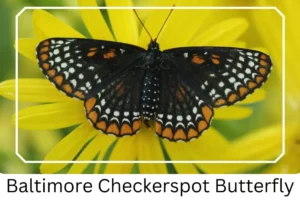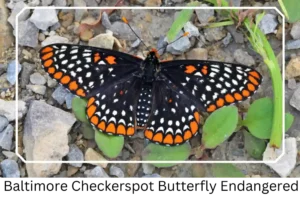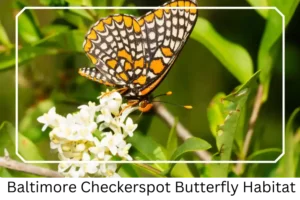Baltimore Checkerspot (Euphydryas phaeton)
The Baltimore Checkerspot is a striking species of butterfly, notable for its vivid colors and patterns. Once prevalent across its range, this species has faced significant declines in recent years, leading to conservation efforts, particularly in Maryland where it is now considered extremely rare. This guide aims to provide an extensive overview of the Baltimore Checkerspot, from its life stages to fascinating facts, ensuring readers are well-informed about this beautiful but threatened butterfly.
Scientific Classification
- Family: Nymphalidae
- Genus: Euphydryas
- Scientific Name: Euphydryas phaeton
Overview
The Baltimore Checkerspot, Euphydryas phaeton, embodies a remarkable journey from egg to adult, showcasing distinct and vibrant colors at each stage of its lifecycle. Its habitats span across various regions in North America, favoring open, sunny wet meadows and upland fields. Despite its once widespread presence, the species’ numbers have dwindled, sparking conservation initiatives to protect its remaining populations. Understanding the Baltimore Checkerspot’s life cycle, habitat preferences, and threats is crucial for its conservation and the maintenance of the biodiversity of its native ecosystems.
Description and Identification
Caterpillar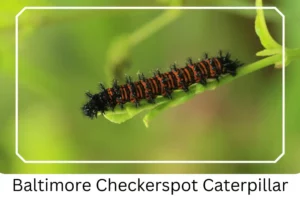
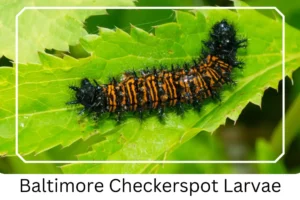
The caterpillar stage of the Baltimore Checkerspot is characterized by a black head, with vibrant yellow and black bands across its body, adorned with spine-like protrusions. These caterpillars exhibit a unique feeding pattern on their host plants and hibernate during winter under dead foliage, preparing for their transformation.
Pupa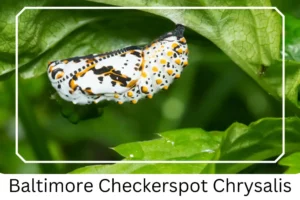
The chrysalis phase lasts about two weeks, featuring a pure white casing dotted with bright orange-yellow and black markings, signaling the nearing emergence of the adult butterfly.
Adult Butterfly
Sexual Dimorphism: This species does not exhibit sexual dimorphism, meaning males and females look alike.
Color and Appearance: With wings unfurled, the butterfly displays a black base accented by white and orange to yellowish-orange checkered borders. The patterns intensify when the wings are closed, making the butterfly appear even more vibrant.
Average Wingspan: Adults boast a wingspan ranging from 1.5 to 2.5 inches.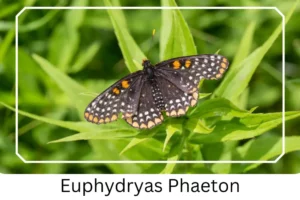
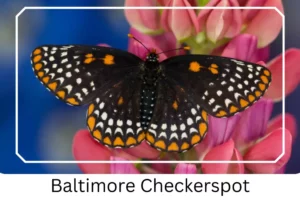
Flight Pattern: Their flight is fast and erratic, often appearing dull and black mid-flight, contrasting sharply with their bright resting appearance.
Eggs
The eggs are a bright yellow, laid in clusters under host plant leaves, showcasing the butterfly’s reproductive strategy.
Quick Facts | |
| Distribution | From west of Nova Scotia, throughout the Great Lakes region to SE Manitoba, and down to the southern parts of the eastern US, north in Georgia, Mississippi, and Oklahoma. |
| Habitat | Prefers open and sunny wet meadows and upland fields. |
| Lifespan of Adults | Estimated between 6 to 9 months. |
| Host Plants | Utilizes Turtlehead (Chelone glabra) before winter; ash (Fraxinus), viburnums, penstemon, plantains (Plantago), and honeysuckle (Lonicera) during spring. |
| Adult Diet | Feeds on nectar from flowers, especially milkweed, viburnum, and wild rose. |
How to Identify Baltimore Checkerspot?
Identifying the Baltimore Checkerspot can be an exhilarating part of nature observation. Look for its distinctive black base wings adorned with checkered patterns of white and orange-yellow. These butterflies are most commonly found in sunny, open wetlands or upland fields, flitting from flower to flower. Pay attention to their unique flight pattern; despite their erratic and fast movements, their colorful wings make them stand out against the green backdrop of their habitats. Additionally, the caterpillars are equally distinctive with their black and yellow bands and spine-like protrusions, often found on host plants like Turtlehead. Observing these characteristics can help enthusiasts and researchers alike to spot and identify this beautiful species in the wild.
Did You Know?
- The Baltimore Checkerspot is named after George Calvert, the first Baron of Baltimore, whose crest featured orange and black, mirroring the butterfly’s colors.
- These butterflies are poisonous to birds, a defense mechanism against predation.
- Despite its beauty, the Baltimore Checkerspot is rarely seen in domestic gardens.
- Since 1973, it has been honored as the state insect of Maryland, a testament to its cultural and ecological significance.
Conclusion
The Baltimore Checkerspot butterfly, with its vibrant colors and unique life stages, is more than just a beautiful insect; it’s a symbol of the delicate balance of our ecosystems. Conservation efforts are crucial to protect this species and ensure its survival for future generations to appreciate and study. By understanding more about its habitat, lifecycle, and the challenges it faces, we can all contribute to the preservation of this remarkable butterfly and the biodiversity of its natural environment.

